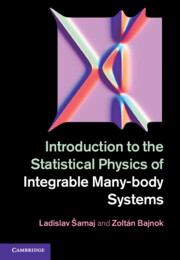Preface
Published online by Cambridge University Press: 05 June 2013
Summary
In classical mechanics, a dynamical system of interacting bodies with 2N-dimensional phase space is said to be integrable if there exist N conserved functions (charges) whose Poisson brackets vanish. For an integrable system in quantum field theory (QFT) there exists an infinite set of commuting conserved charges. The existence of the conserved charges allows us to solve the physical system exactly and in this way to describe the modeled phenomena without any approximation. Although the integrability is restricted to low dimensions, the exact solution often provides general information about the physical phenomena. At present, we know precisely how to generate systematically integrable models and how to solve them, explicitly or implicitly in the form of integral equations.
Integrable models cover many domains of quantum mechanics and statistical physics:
Non-relativistic one-dimensional (1D) continuum Fermi and Bose quantum gases with specific types of singular and short-range interactions.
1D lattice and continuum quantum models of condensed-matter physics, like the Heisenberg model of interacting quantum spins, the Hubbard model of hopping electrons with one-site interactions between electrons of opposite spins, the Kondo model describing the interaction of a conduction band with a localized spin impurity, microscopic models of superconductors, etc.
Relativistic models of QFT in a (1+1)-dimensional spacetime like the sine-Gordon model and its fermionic analog, the Thirring model, and so on.
Two-dimensional (2D) lattice and continuum classical models in thermal equilibrium like the lattice Ising model of interacting nearest-neighbor ±1 spins, the six- and eight-vertex models, the continuum Coulomb gas of ±1 charges interacting by a logarithmic potential, etc.
- Type
- Chapter
- Information
- Publisher: Cambridge University PressPrint publication year: 2013

